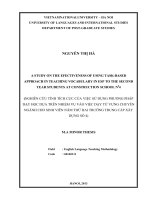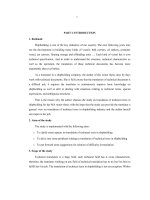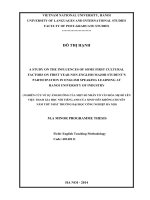A STUDY ON THE EFFECTIVENESS OF WASP AND ONLINE AUDIO RECORDER TO DEVELOP SENTENCE INTONATION REPRODUCTION BY FIRST YEAR
Bạn đang xem bản rút gọn của tài liệu. Xem và tải ngay bản đầy đủ của tài liệu tại đây (317.08 KB, 55 trang )
VIETNAM NATIONAL UNIVERSITY, HANOI
UNIVERSITY OF LANGUAGES AND INTERNATIONAL STUDIES
FACULTY OF POST-GRADUATE STUDIES
*********************
MAI CÔNG TRÌNH
A STUDY ON THE EFFECTIVENESS OF WASP AND ONLINE
AUDIO RECORDER TO DEVELOP SENTENCE INTONATION
REPRODUCTION BY FIRST-YEAR, NON-MAJOR STUDENTS AT
UNIVERSITY OF SCIENCES – THAI NGUYEN UNIVERSITY
Nghiên cứu về hiệu quả của các phần mềm WASP và Online audio recorder
trong việc nâng cao khả năng bắt chước ngữ điệu câu của sinh viên tiếng Anh
không chuyên năm thứ nhất tại Đại học Khoa học - Đại học Thái Nguyên
M.A MINOR PROGRAMME THESIS
FIELD: ENGLISH TEACHING METHODOLOGY
CODE: 60140111
Hanoi, 2015
VIETNAM NATIONAL UNIVERSITY, HANOI
UNIVERSITY OF LANGUAGES AND INTERNATIONAL STUDIES
FACULTY OF POST-GRADUATE STUDIES
*********************
MAI CÔNG TRÌNH
A STUDY ON THE EFFECTIVENESS OF WASP AND ONLINE
AUDIO RECORDER TO DEVELOP SENTENCE INTONATION
REPRODUCTION BY FIRST-YEAR, NON-MAJOR STUDENTS AT
UNIVERSITY OF SCIENCES – THAI NGUYEN UNIVERSITY
Nghiên cứu về hiệu quả của các phần mềm WASP và Online audio recorder
trong việc nâng cao khả năng bắt chước ngữ điệu câu của sinh viên tiếng Anh
không chuyên năm thứ nhất tại Đại học Khoa học - Đại học Thái Nguyên
M.A MINOR PROGRAMME THESIS
FIELD: ENGLISH TEACHING METHODOLOGY
CODE: 60140111
SUPERVISOR: ASSOC. PROF. VÕ ĐẠI QUANG, Ph.D.
Hanoi, 2015
CERTIFICATE OF ORIGINALITY
I, the undersigned, hereby certify my authority of the study project report entitled:
A study on the effectiveness of WASP and Online audio recorder to develop
sentence intonation reproduction by first-year, non-major students at University
of Sciences – Thai Nguyen University.
Submitted in partial fulfillment of the requirements for the degree of MA in English
Teaching Methodology.
Except where the reference is indicated, no other person’s work has been used
without due acknowledgement in the text of the thesis.
Hanoi, August 2014
Mai Cong Trinh
i
ACKNOWLEDGEMENTS
This thesis could not have been completed without the help and support from a
number of people.
First and foremost, I would like to express my sincere gratitude to Assoc. Prof. Dr.
Vo Dai Quang, my supervisor, who has patiently and constantly supported me
through the stages of the study, and whose stimulating ideas, expertize, and
suggestions have inspired me greatly through my growth as an academic researcher.
A special word of thanks goes to my colleagues at University of Sciences – TNU
who have helped me in piloting the materials and making constructive and
insightful comments as well as suggestions for this paper, and many others, without
whose support and encouragement it would never have been possible for me to have
this thesis accomplished.
Last but not least, I am greatly indebted to my family, my wife for the sacrifice they
have devoted to the fulfillment of this academic work.
ii
ABSTRACT
This study investigates whether first-year, non-major students at University of
Sciences – Thai Nguyen University perceive and reproduce accurate intonation
contours of sentences in English after two weeks of training with WASP and Online
Audio Recorder focusing on two types of intonation patterns (definite statements,
yes/no questions). The study found that the learners improved their correctness in
reproducing the intonation patterns according to the results and analyses of pre-test,
post-test and interview. The participants also stated that the tools were beneficial,
interesting to use and helpful for their learning. The study also motivates future
research in some kinds of aspects related.
iii
LIST OF ABBREVIATIONS
L1: First Language
L2: Second Language
ASR: Automatic Speech Recognition
CMS: Course Management System
TNU: Thai Nguyen University
iv
LIST OF TABLES
Table 1. Participants’ information 13
Table 2. Summary of Design Study 15
Table 3. Pre-test results 28
Table 3. Post-test results 28
v
LIST OF FIGURES
Figure 1. Preview of an exercise in Moodle 23
Figure 2. Visual display of the utterance
“My car’s in the car park.” in WASP 24
Figure 3. Visual display of “Did you have a good time?”
first made by a participant in the training phase 32
Figure 4. Visual display of “Did you have a good time?” made by a
participant after several attempts in the training phase 33
vi
TABLE OF CONTENTS
Certificate of Originality i
Acknowledgements ii
Abstract iii
List of Abbreviations iv
List of Tables v
List of Figures vi
Table of contents vii
PART A: INTRODUCTION 1
1. Rationale for the study 1
2. Aims of the study 2
3. Objectives of the study 2
4. Scope of the study 2
5. Design of the study 3
PART B: DEVELOPMENT 4
Chapter 1: Literature review 4
1.1. Theoretical Background 4
1.1.1. Intonation theory 4
1.1.2. Technology for Learning 7
1.1.3. Technology-based Intonation Teaching 8
1.2. Review of Previous Studies Related to the Research 9
1.3. Summary 11
vii
Chapter 2: Methodology 12
2.1. Research-governing Orientations 12
2.1.1. Research Question 12
2.1.2. Research Hypothesis 12
2.1.3. Participants 12
2.2. Research Methods 13
2.2.1. Methods 13
2.2.2. Instruments/ Materials 16
2.2.3. Preparing the Materials 16
2.2.3.1. Questionnaire 16
2.2.3.2. Interview 16
2.2.3.3. Pre-test and Post-test 16
• Sentences 17
• Conversations 17
2.2.3.4. Piloting 17
2.2.3.5. Final Materials 18
2.2.3.6. Pre- and Post-tests Materials 18
2.2.3.7. Training Materials 19
• Moodle Familiarization 19
• Perception and Reproduction Training 19
2.2.3.8. Testing and Training Applications 19
• Moodle 19
• WASP 20
• Online Audio Recorder 20
2.3. Procedure for Data Collection 20
• Familiarization Phase 20
• Pre-test Phase 21
• Training Phase 22
• Post-test Phase 22
viii
2.4. Data Processing and Analysis 25
2.5. Summary 25
Chapter 3: Findings and Discussions 26
3.1. What effects does the training with the tools have on participants’
perception, reproduction of definite statements and yes/no questions? 27
3.1.1. Perception 27
3.1.2. Reproduction 29
3.1.3. Connection between Perception and Reproduction…………… 30
3.3. Summary 31
PART C: CONCLUSION 34
1. Concluding Remarks 34
1.1. Conclusion on the Research Question 34
2. Limitations of the Study 35
3. Suggestions for Future Research 36
REFERENCES 37
BIBLIOGRAPHY 38
APPENDIX A I
APPENDIX B II
ix
PART A: INTRODUCTION
1. Rationale for the Study
It cannot be denied that technology nowadays has been developing really fast.
All fields of everyday life are covered by computers and Internet, which
creates chances for teachers, and researchers to integrate technology in
educational settings. However, most of applications of technology are now
seen under the term “Technology of Education” as Gupta (2010) defined in
her study. It means that technology are considered as a medium for teachers to
prepare digitalized lectures, learning materials, teaching aids… Very few of
teachers pay attention to the use of “Technology in Education” that Gupta
(2010) clarified as the use of technology to improve learning and meet
learners’ needs.
From the facts mentioned above, the author decided to investigate if
technology-based tools can improve the students’ reproduction of sentence
intonation. Following Kern’s (2006) ideas about the use of technology: “In
the tutor role, computers can provide instruction, feedback, and testing in
grammar, vocabulary, writing, pronunciation, and other dimensions of
language and culture learning In the tool role, computers provide ready
access to written, audio, and visual materials relevant to the language and
culture being studied In the medium role, technology provides sites for
interpersonal communication, multimedia publication, distance learning,
community participation, and identity formation” (p. 191, 192). This study
focused on the use of technology as “tutor” and “tool” in case of the study
“on the effectiveness of WASP and Online audio recorder to develop sentence
intonation reproduction by first – year, non – major students at University of
Sciences – Thai Nguyen University.”
10
2. Aims of the Study
The study explores the effectiveness of WASP and Online audio recorder to
develop sentence intonation reproduction by first – year, non – major students
at University of Sciences – Thai Nguyen University. The major aims of the
study are to:
• Make use of tools WASP and Online Audio Recorder to improve
students’ sentence intonation in terms of perception and reproduction.
• Confirm the easiness of the two open-access tools to the learning of
intonation and pronunciation in particular, and English learning in
general.
3. Objectives of the Study
The objectives of the study were further elaborated into the research question
which can be stated as follows:
What effects does the training with the tools have on participants’ perception,
reproduction of definite statements and yes/no questions?
4. Scope of the Study
It would be too ambitious for this minor thesis to cover all functions of
WASP and Online Audio Recorder in learning all intonation patterns. Thus,
the author chose to focus on the effectiveness of the two tools in perceiving
and reproducing of two types of intonation patterns which are of definite
statements and yes/no questions. The study was also conducted within 03
11
participants who are non-major, first-year students at University of Sciences –
TNU.
12
13
5. Design of the Study
The study comprises of three parts: Introduction, Development and
Conclusion.
Part A: Introduction presents the rationale, aims, objectives, scope and
design of the study.
Part B: Development consists of 3 chapters:
Chapter 1: Literature Review gives the theoretical background to
Intonation and Intonation teaching as well as reviews the previous studies
related to the research area of the thesis.
Chapter 2: Methodology gives the details of governing orientations of
the research and research methods of the study.
Chapter 3: Findings and Discussion deals with the results and
discusses the results.
Part C: Conclusion summarizes the main points presented in the thesis,
proposes the limitations of the research, and makes suggestions for future
research.
14
PART B: DEVELOPMENT
Chapter 1: Literature Review
1.1. Theoretical Background
1.1.1. Intonation Theory
Intonation has been described as “the rising and falling of the voice to various
pitch levels during the articulation of an utterance” (Celce-Murcia, et al.,
1996, p. 184) or, “the pitch pattern in a sentence” (Ladefoged, 2006, p. 23).
The role of intonation is central to human discourse on the grounds that it is
important in conveying meaning. Each native speaker of a language can
comprehend and use intonation to convey his or her message; however, non-
native speakers are sometimes not able to utilize intonation as a part of ways
that suit the planned message. According to Verdugo and Trillo (2005), native
speakers impart successfully via naturally selecting the proper prosodic
patterns, lexical and context oriented data. They do so due to their earlier
learning and involvement in a specific connection. On the other hand, non-
native speakers may have less encounter, and therefore may have deficient
information of the second language (L2), which implies they utilize wrong
intonation patterns within specific connections. Spaai and Hermes (1993)
clarified that language learners regularly superimpose the prosodic (features
of rhythm, stress, and intonation) of their first language (L1) on the
resonances of the language learned. This is on account of the suprasegmental
peculiarities and patterns of the speakers’ L1 are profoundly established.
Subsequently, language learners are regularly uninformed of contrasts in
intonation between their first language and a second language, and of how
diverse intonation patterns can influence importance in the second language.
15
Ladd (1980) has shown the problems assuming that speakers choose
intonation contours based on grammar alone. He [Ladd (1980)] also claimed
that intonation patterns can be seen as in the same way as lexical words.
Referring to Liberman, (1967, p.141) intonation contours contain “an abstract
context-free element of meaning, which produces specific nuances in specific
contexts”. Intonation contours, therefore, cannot be separated from their
context without losing some of their meaning. However, it is impossible to
teach every nuance but the general and salient rules of intonation.
Syntactically-defined contours are salient, and it is can be considered that
syntax is the default determining function for intonation, although discourse
functions may overrule it. Following the recommendations of Celce-Murcia et
al. (1996), the author chose to focus on two syntactically-defined contours
which were intonation contours of definite statements and yes/no questions.
Of the two intonation contours, a definite statement tends to have the final
falling intonation and a yes/no question usually has the final rising intonation.
This study focused only on the default contours of these two kinds of
sentences.
In order for language learners to take in these features it is necessary for them
to perceive and reproduce them. Examines on the learning of second language
phonology have not definitively indicated whether L2 speakers learn to
perceive before they learn to reproduce aspects of L2 phonology, or the other
way around. For instance, Archibald found that Hungarian and Polish native
speakers, whose languages have predictable stress patterns, scored better in
the perception of stress for English verbs and nouns than in the reproduction
of the stress (1993, citing in Altmann, 2006). Atmann’s 2006 study uncovered
a quite opposite results with participants who were native speakers of
16
predictable-stress-pattern languages. He (Altmann, 2006) showed that
participants with a lower performance in the perception of stress for English
words had a very good performance in the reproduction task. The studies
above show that the relationship between perception and reproduction of
suprasegmentals requires learners to engage in both perception and
reproduction tasks.
1.1.2. Technology for Learning
Over the past few decades, technological devices, including computers, have
become an indispensable part of our daily lives. According to Gupta (2010),
technology today is in the reach of more people because it has become
cheaper. Moreover, compared to the past, many more students are very
comfortable using technology in many fields. All these changes have
prompted the integration of technology in educational settings. Gupta (2010)
made clear on the differences between two uses of technology: technology of
education and technology in education. Technology of education is
considered to be a medium which helps instructors prepare learning materials
such as video lectures and digitized lectures. However, technology in
education is used to improve learning and meet learners’ needs. In terms of
language learning, according to Kern (2006), the use of technology can be
seen in terms of the metaphors of tutor, tool, and medium:
“In the tutor role, computers can provide instruction, feedback, and
testing in grammar, vocabulary, writing, pronunciation, and other dimensions
of language and culture learning In the tool role, computers provide ready
access to written, audio, and visual materials relevant to the language and
culture being studied In the medium role, technology provides sites for
17
interpersonal communication, multimedia publication, distance learning,
community participation, and identity formation” (p. 191, 192).
1.1.3. Technological-based Intonation Teaching
Teachers and researchers have raised the worry that the intonation of a second
language is troublesome both to teach and to learn in the language classroom
(Park, 2011). However, because of specific attributes of technology-based
instructions, there is an expanding tendency to show and learn second
language intonation through the uses of technology and software. In this
thesis, the design and possibility of an instrument which uses open-access
devices to enhance L2 English learners' perception and reproduction of
English intonation is described.
Non-native-like intonation could lead to misunderstandings. One famous
example was described in Gumperz (1982) that native speakers misinterpreted
non-native speakers' intonation. Non-native cafeteria workers from the Indian
used a falling tone on the word “gravy” to ask if customers wanted gravy
(p.173-174). Native speakers perceived the workers to be rude because the
native-like intonation should have been a rising tone on “gravy.” A
linguistically inappropriate intonation contour can result in misinterpretation
and even conflict, showing why such teaching intervention applied in this
study is needed.
Nowadays, technological devices have been used in a large range of any
fields including teaching and learning. In the case of English, many teachers
and researchers see them as tools for communication, teaching and learning.
18
In those terms mentioned, Thorne and Smith (2011) have identified at least
three potential uses of technology in language learning:
“… to provide access to input and rehearsal (recording, tutorials, and
drills), to amplify possibilities for personal expression (text and media
processing), to extend existing and enable new opportunities for interpersonal
communication (synchronous and asynchronous messaging)…” (p.268)
One advantage of using technology is that it can provide “relevant and useful
feedback” (Zhao, 2003, p.21). Thomson (2011) showed that a number of
applications available can provide visual feedback to language learners which
is simple for them to interpret, helping learners to develop some specific
aspects of second language pronunciation. Moreover, he claimed, visual
displays or feedback showing contours of pitch, relative segments and
amplitude of segments, are likely to be very effective for the teaching of
suprasegmentals such as, intonation, rhythm and stress.
1.2. Review of Previous Studies Related to the Research
It is clear that using technology in language learning is not the same as using
technology effectively in language learning. In this part, the author will look
at previous studies on using technology for language learning and the ways in
which technology has been used effectively to help language learners with a
challenging aspect of English: perceiving and reproducing intonation patterns.
In many language classrooms, there is not enough time for learners to practice
their oral reproduction and communication. Technology can be used to
provide opportunities for oral reproduction. In a study by Holland, Kaplan
and Sabol (1999), students’ reproduction and production of Arabic utterances
19
improved as a result of an interactive Microworld application with automatic
speech recognition (ASR).
Hirata (2010) concluded in his study that English learners of Japanese, who
used the CSL-Pitch Program to look at pitch and duration of speech, could
perceive and produce Japanese words correctly using appropriate pitch and
durational contrasts.
A study by Anderson-Hsieh (1992) showed that with the help of a program
called Visi-Pitch, participants could easily reproduce the targeted
suprasegmentals.
In another study, Hardison (2004) made it clear that learners who received
training in intonation with visual display improved their reproduction and
production at the suprasegmental level. Despite the participants were not
provided with explicit instructions, they still produced a significant progress.
Taniguchi and Abberton (1999) revealed in their study that a group of
Japanese learners of English improved their reproduction of English
intonation and the naturalness in English intonation after being exposed to
interactive visual feedback.
According to de Bot (1983), participants can easily make decisions based on
what they see in audiovisual feedback, depending on how similar the imitated
contours are to the originals. The participants’ imitation is visualized through
a picture which motivates them to either repeat an imitation or try a new one.
To summarize the above, technology has played a successful role to implicitly
train non-native speakers to perceive, reproduce and produce particular
features of intonation. However, the above studies used the tools that required
specialized knowledge of intonation systems and instrumental phonetics.
20
These tools were generally expensive and not available to the public. So, in
this study the author explore the use of accessible and user-friendly
technological tools in providing audio-visual feedback to help learners
improve their perception and reproduction of English intonation with a
particular focus on definite statements and yes/no questions. The study was
inspired by Moussalli (2013) whose study proved the learners’ enhancement
of perception and production of tag questions after working with the two
tools.
1.3. Summary
To the author’s knowledge, there are a limited number of studies on the use of
technology to help non-native speakers, especially Vietnamese learners of
English, to perceive and reproduce sentence intonation. Therefore, this study
were decided to concentrate on open-access tools which incorporates
computer-based audio-visual feedback. One was delivered through the
activity module for Moodle: Online Audio Recording, and the other was
through the application WASP. It is to help non-major first year students in
University of Sciences – TNU improve their perception and reproduction of
falling and rising in definite statements and yes/no questions.
21
Chapter 2: Methodology
2.1. Research-governing Orientations
2.1.1. Research Question
The researcher adopted action research approach in order to find answers to
the research question:
What effects does the training with the tools have on participants’ perception,
reproduction of definite statements and yes/no questions?
It is because action research is beneficial in area of teaching practice that need
to be explored. In the context of the present study, it is to employ the
computer-based tools to improve participants’ perception and reproduction of
sentence intonation and find out how effective these tools are.
2.1.2. Research Hypothesis
It is predicted that learners after being trained with the audio-visual feedback
might perform better in their perception and reproduction of the sentence
intonation than before.
2.1.3. Participants
Three participants were chosen randomly from an intensive English class for
first year students at University of Sciences – TNU. The students in the class
are better at English than the average. They had been tested and qualified to
study with the aim for the outcomes of B1 – CEFR. General information for
the three participants who participated in the study is summarized in Table 1.
(Each participant was assigned with a code-name in the study.)
22
Table 1 Participants information.
Participants Code-name Gender Age Location
Hưng P01 Male 20 Lai Châu
Huyền P02 Female 21 Lạng Sơn
Trang P03 Female 20 Bắc Kạn
2.2. Research Methods
2.2.1. Methods
Action research applied in this thesis follows MacIsaac’s (1983) simple model
which includes four steps:
• Plan – described in Instruments/ Materials and Preparing the
Materials
• Act – described in Procedure for Data Collection
• Observe – described in Data Processing and Analysis
• Reflect – described in Findings and Discussions; Conclusion.
Within the research, the authors employed some of the techniques which are
listed as follows:
• Launching questionnaire at the beginning of the study to collect
participants’ background information.
• Implementing pre-test, training and post-test to collect the data. The
study underwent three phases: a familiarization and pre-test phase, a
training phase, and a post-test phase. Table 2 shows the tasks and time
periods for each phase.
• Analyzing the data collected and discuss the scores.
• Conducting an interview to get the participants’ performance and
opinions.
23

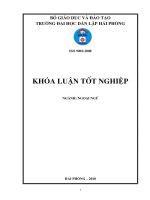
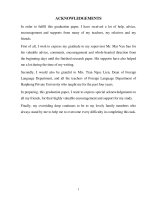
![gherghina et al - 2014 - a study on the relationship between cgr and company value - empirical evidence for s&p [cgs-iss]](https://media.store123doc.com/images/document/2015_01/02/medium_JKXoRwVO1T.jpg)
